Click on images to enlarge

habit (Photo: Sheldon Navie)
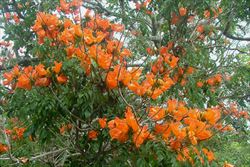
habit (Photo: Sheldon Navie)
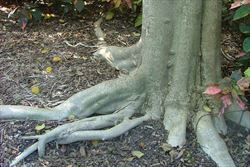
butressed trunk (Photo: Sheldon Navie)
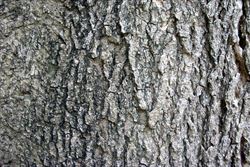
rough bark on main trunk (Photo: Sheldon Navie)

close-up of younger stem, showing the whitish spots, and leaf stalks (Photo: Sheldon Navie)
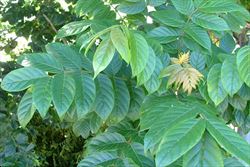
large once-compound leaves (Photo: Sheldon Navie)

close-up of leaflet bases showing the tiny raised glands (Photo: Sheldon Navie)
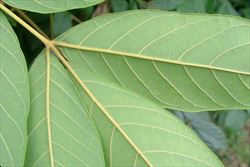
leaflet undersides (Photo: Sheldon Navie)
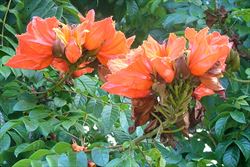
flower clusters (Photo: Sheldon Navie)
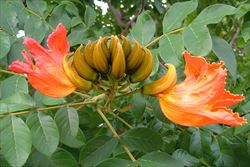
flowers with horn-shaped calyx tubes (Photo: Sheldon Navie)
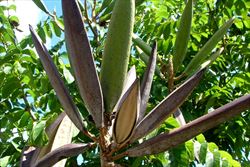
immature and mature fruit (Photo: Sheldon Navie)
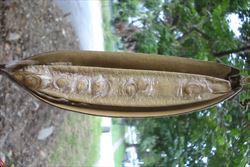
old fruit with a few remaining seeds (Photo: Sheldon Navie)
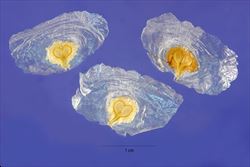
close-up of seeds (Photo: Steve Hurst at USDA PLANTS Database)
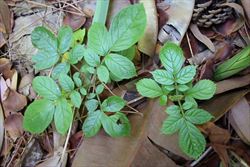
seedlings (Photo: Sheldon Navie)

root sucker growing in a lawn (Photo: Sheldon Navie)

sapling (Photo: Sheldon Navie)
Scientific Name
Spathodea campanulata P. Beauv.
Synonyms
Spathodea campanulata P. Beauv. subsp. nilotica (Seem.) Bidgood
Family
Bignoniaceae
Common Names
African tulip, African tulip tree, African tulip-tree, African tuliptree, fireball, flame of the forest, flame tree, fountain tree, fountaintree
Origin
Native to tropical western Africa (i.e. Burundi, Cameroon, Equatorial Guinea, Gabon, Rwanda, Zaire, Benin, Ivory Coast, Ghana, Guinea, Liberia, Nigeria, Sierra Leone, Togo and Angola).
Cultivation
Widely cultivated as a garden and street tree. A yellow-flowered cultivar, known as yellow African tulip tree (Spathodea campanulata 'Aurea'), is also occasionally grown as an ornamental in Australia.
Naturalised Distribution
This species is not yet widely naturalised, but it is cultivated throughout large parts of the country as a garden plant and street tree. It has a scattered distribution in the coastal areas of central and northern Queensland and is present in the northern parts of the Northern Territory. It is also becoming naturalised on Christmas Island and in south-eastern Queensland.
Also naturalised in the Mascarenes (i.e. the Seychelles and La Réunion), Singapore, south-eastern USA (i.e. Florida) and on several Pacific islands (i.e. the Cook Islands, Fiji, French Polynesia, Vanuatu, Guam, Niue, Palau, Western Samoa, Tonga and Hawaii).
Habitat
A tree that invades abandoned agricultural land, roadsides, waterways, disturbed sites, waste areas, forest margins and disturbed rainforests in tropical and sub-tropical regions. It favours wetter habitats, and is especially common along creeks and gullies.
Habit
A large upright tree (growing up to 25 m tall) with a spreading crown and a slightly buttressed trunk.
Distinguishing Features
- a large tree with large compound leaves arranged in pairs along the branches.
- its large and very showy flowers (10-12 cm long) are borne in clusters at the tips of the branches.
- these flowers are orange-red, somewhat tulip-shaped, and have yellowish crinkled margins.
- its large elongated capsules (up to 30 cm long) resemble pods and split open to release numerous papery seeds.
Stems and Leaves
The branches are thick and marked with small whitish-coloured corky spots (i.e. lenticels). Younger branches vary from being almost hairless (i.e. sub-glabrous) to having a sparse covering of small hairs (i.e. puberulent).
The large leaves (up to 50 cm long) are compound (i.e. pinnate) with 7-17 leaflets. These leaves are usually oppositely arranged along the stems and are borne on stalks (i.e. petioles) up to 6 cm long. The leaflets (up to 15 cm long and 7.5 cm wide) are broadly oval (i.e. elliptic) or egg-shaped in outline (i.e. ovate) and have entire margins. They have a sparse covering of soft hairs (i.e. they are puberulent) and the extension of the leaf stalk (i.e. the rachis) is usually covered in brownish coloured hairs. At the base of each leaflet there are usually two or three tiny raised structures (i.e. glands).
Flowers and Fruit
The large and very showy flowers are arranged in dense clusters (8-10 cm long) at the tips of the branches (i.e. in terminal racemes) on stalks (i.e. peduncles) up to 10 cm long. Individual flowers are borne on short stalks (i.e. pedicels) that are covered in brownish-coloured hairs. These flowers have sepals that are fused into a horn-shaped structure (i.e. calyx tube) that splits along one side as the flowers open. This distinctive horn-shaped calyx is curved upward, somewhat ribbed, and brownish in colour (about 5 cm long). The reddish-orange coloured petals (10-12 cm long) are also fused together (i.e. into a corolla tube) and are shaped somewhat like a tulip flower (i.e. they are tubular). The mouth of the flower is about 7 cm across and has several indistinct lobes with crinkled (i.e. crisped) margins that are yellowish in colour. Each flower also has four stamens with large dark brown anthers (about 15 mm long) that are borne on stalks (i.e. filaments) about 5 cm long. They also have a long yellow style (8 cm long) topped with a reddish stigma. Flowering occurs throughout the year, but usually peaks during spring.
The large and elongated capsules (17-30 cm long and 3.5-5 cm wide) resemble pods. They are slightly flattened and turn from green to brown in colour as they mature. When mature they split open and release about 500 papery seeds. These seeds are very light and surrounded by a see-through (i.e. translucent) membranous wing.
Reproduction and Dispersal
This plant reproduces mostly by seeds, which are light and usually released from a significant height. Larger trees may also spread via root suckers, particularly when they are damaged.
Seeds are most commonly wind-dispersed, but they may also be spread by water (if plants are growing along waterways) and in dumped garden waste.
Environmental Impact
African tulip tree (Spathodea campanulata) is regarded as a significant environmental weed in Queensland, the Northern Territory, and on Christmas Island. It is also regarded as a potential environmental weed or "sleeper weed" in northern New South Wales and other parts of northern Australia.
This species is also listed in the Global Invasive Species Database (GISD), and is regarded to be among the top 100 of the world’s worst invasive alien Species.
Legislation
This species is declared under legislation in the following states and territories:
- Queensland: Class 3 - this species is primarily an environmental weed and a pest control notice may be issued for land that is, or is adjacent to, an environmentally significant area (throughout the entire state). It is also illegal to sell a declared plant or its seed in this state.
- Western Australia: Unassessed - this species is declared in other states or territories and is prohibited until assessed via a weed risk assessment (throughout the entire state).
Management
For information on the management of this species see the following resources:
- the Biosecurity Queensland Fact Sheet on this species, which is available online at http://www.daff.qld.gov.au.
Similar Species
African tulip tree (Spathodea campanulata) is very distinctive, and is rarely confused with other species.

